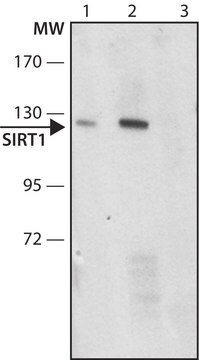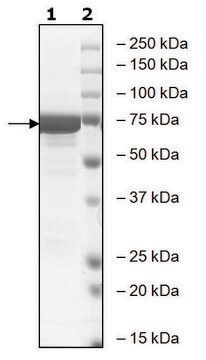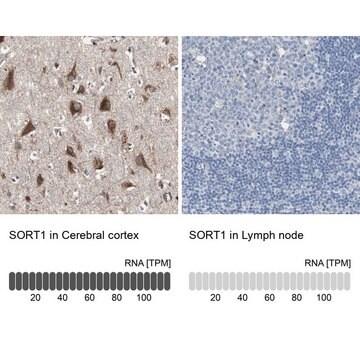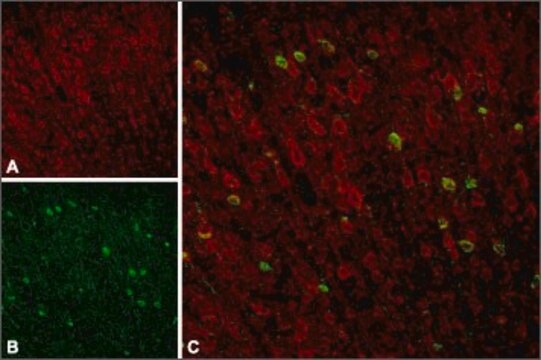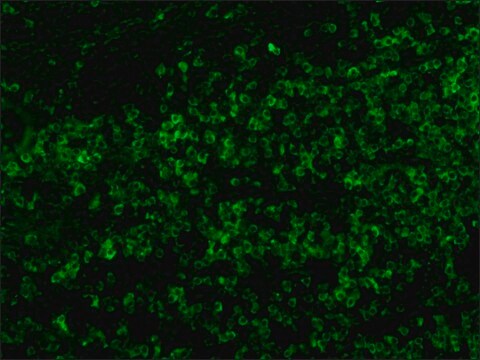MABN1792
Anti-Sortilin Antibody, clone F11
clone F11, from mouse
Synonyme(s) :
Sortilin, 100 kDa NT receptor, Glycoprotein 95, Gp95, Neurotensin receptor 3, NT3, NTR3
About This Item
Produits recommandés
Source biologique
mouse
Niveau de qualité
Forme d'anticorps
purified immunoglobulin
Type de produit anticorps
primary antibodies
Clone
F11, monoclonal
Espèces réactives
mouse, human
Technique(s)
ELISA: suitable
immunocytochemistry: suitable
immunohistochemistry: suitable (paraffin)
western blot: suitable
Isotype
IgG1κ
Numéro d'accès NCBI
Numéro d'accès UniProt
Conditions d'expédition
wet ice
Modification post-traductionnelle de la cible
unmodified
Informations sur le gène
human ... SORT1(6272)
Description générale
Immunogène
Application
Immunocytochemistry Analysis: Representative lots detected cellular localization of exogenously expressed sortilin in transfected HEK293 cells by fluorescent immunocytochemistry (Larsen, J.V., et al. (2014). Biochem J. 457(2):277-288; Gustafsen, C., et al. (2013). J Neurosci. 33(1):64-71; Larsen, J.V., et al. (2010). Mol. Cell. Biol. 30(17):4175-4187; Nielsen, M.S., et al. (2007). Mol. Cell. Biol. 27(19):6842-6851).
ELISA Analysis: A representative lot was employed as the detection antibody in sandwich ELISA. A positive correlation was found between PCSK9 and soluble sortilin in human serum samples from healthy individuals (Gustafsen, C., et al. (2014). Cell Metab. 19(2):310-318).
Western Blotting Analysis: A representative lot detected different distribution of Sortilin than SorLA among subcellular fractions obtained by gradient centrifugation (Nielsen, M.S., et al. (2007). Mol. Cell. Biol. 27(19):6842-6851).
Neuroscience
Developmental Neuroscience
Qualité
Immunohistochemistry Analysis: A 1:50 dilution of this antibody detected Sortilin in human cerebral cortex tissue.
Description de la cible
Forme physique
Stockage et stabilité
Autres remarques
Clause de non-responsabilité
Vous ne trouvez pas le bon produit ?
Essayez notre Outil de sélection de produits.
Code de la classe de stockage
12 - Non Combustible Liquids
Classe de danger pour l'eau (WGK)
WGK 1
Point d'éclair (°F)
Not applicable
Point d'éclair (°C)
Not applicable
Certificats d'analyse (COA)
Recherchez un Certificats d'analyse (COA) en saisissant le numéro de lot du produit. Les numéros de lot figurent sur l'étiquette du produit après les mots "Lot" ou "Batch".
Déjà en possession de ce produit ?
Retrouvez la documentation relative aux produits que vous avez récemment achetés dans la Bibliothèque de documents.
Notre équipe de scientifiques dispose d'une expérience dans tous les secteurs de la recherche, notamment en sciences de la vie, science des matériaux, synthèse chimique, chromatographie, analyse et dans de nombreux autres domaines..
Contacter notre Service technique

